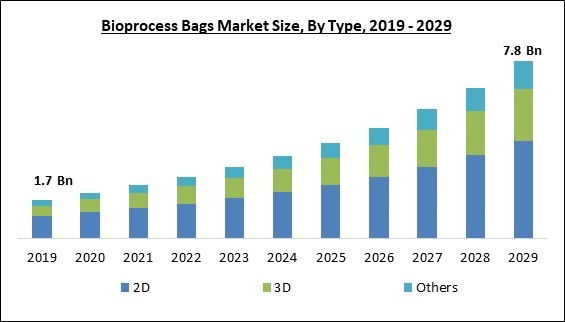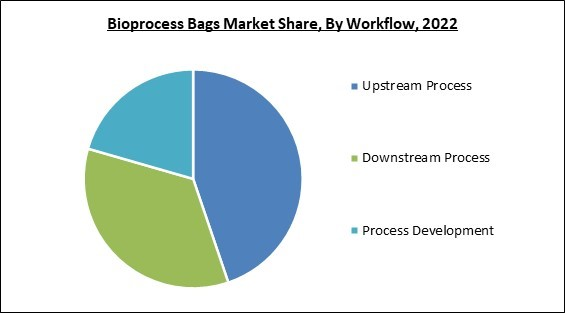The Global Bioprocess Bags Market size is expected to reach $7.8 billion by 2029, rising at a market growth of 16.5% CAGR during the forecast period.
3D bioprocess bags is the major contributor to the market as these bioprocess bags are used to store bioprocess substances during the manufacturing and research for novel medicines for chronic diseases, thereby it is expected to generate more than 28% share of the market by 2029. According to WHO, over 75 percent (31.4 million) of all fatalities from noncommunicable diseases worldwide occur in nations with low or middle incomes disproportionately affected by NCDs. NCDs affect individuals of every age, location, and country and around seventeen million deaths from noncommunicable diseases (NCDs) occur before 70, even though these diseases are typically associated with senior age groups. Estimates indicate that low- and middle-income countries are responsible for 86% of this early mortality. Some of the factors impacting the market are rising demand for biopharmaceuticals, benefits of integrating single-use technology into the biomanufacturing process, and the removal of waste presenting a serious challenge.
Companies in the pharmaceutical and biotechnology industries have been able to reap the rewards. They are now adopting single-use technology to eliminate the flaws and delays in the manufacturing process. The short turnaround time, lean manufacturing process, and schedule flexibility afforded to the factory floor, together with the cheaper start-up cost, are the primary advantages of single-use. The increased prevalence of chronic diseases like diabetes, cancer, and cardiovascular disorders drives the demand for biological therapies. In this regard, it is anticipated that factors such as the rising senior population, the prevalence of related health problems, and the surging demand for sophisticated biologic drugs will foster a favorable environment for the biopharmaceutical industry's participants to expand.
However, the disposal of solid waste and rising waste management expenses are two issues that biomanufacturing businesses must deal with when using single-use components like bioprocess bags. But, in reality, businesses that use single-use bioprocessing are responsible for a very small percentage of the world's plastic usage. Thus, the adoption of single-use bioprocess bags may be restricted due to the difficulties of trash disposal, limiting the market growth.
The pandemic has caused disruptions in the supply chain and shortages of basic materials, affecting bioprocess bag production. In addition, the pandemic has caused a shift in emphasis toward producing COVID-19-related products, which has slowed the manufacture of non-COVID-related products, such as bioprocess sacks, hindering market growth. The market's development slowed slightly during the initial period but later recovered and grew due to the aforementioned factors.
The market research report covers the analysis of key stake holders of the market. Key companies profiled in the report include Thermo Fisher Scientific, Inc., Sartorius AG, Danaher Corporation, Saint-Gobain Group, Corning Incorporated, Meissner Filtration Products, Inc., Merck KGaA, Entegris, Inc., PROAnalytics, LLC, and CellBios Healthcare and Lifesciences Pvt Ltd.
3D bioprocess bags is the major contributor to the market as these bioprocess bags are used to store bioprocess substances during the manufacturing and research for novel medicines for chronic diseases, thereby it is expected to generate more than 28% share of the market by 2029. According to WHO, over 75 percent (31.4 million) of all fatalities from noncommunicable diseases worldwide occur in nations with low or middle incomes disproportionately affected by NCDs. NCDs affect individuals of every age, location, and country and around seventeen million deaths from noncommunicable diseases (NCDs) occur before 70, even though these diseases are typically associated with senior age groups. Estimates indicate that low- and middle-income countries are responsible for 86% of this early mortality. Some of the factors impacting the market are rising demand for biopharmaceuticals, benefits of integrating single-use technology into the biomanufacturing process, and the removal of waste presenting a serious challenge.
Companies in the pharmaceutical and biotechnology industries have been able to reap the rewards. They are now adopting single-use technology to eliminate the flaws and delays in the manufacturing process. The short turnaround time, lean manufacturing process, and schedule flexibility afforded to the factory floor, together with the cheaper start-up cost, are the primary advantages of single-use. The increased prevalence of chronic diseases like diabetes, cancer, and cardiovascular disorders drives the demand for biological therapies. In this regard, it is anticipated that factors such as the rising senior population, the prevalence of related health problems, and the surging demand for sophisticated biologic drugs will foster a favorable environment for the biopharmaceutical industry's participants to expand.
However, the disposal of solid waste and rising waste management expenses are two issues that biomanufacturing businesses must deal with when using single-use components like bioprocess bags. But, in reality, businesses that use single-use bioprocessing are responsible for a very small percentage of the world's plastic usage. Thus, the adoption of single-use bioprocess bags may be restricted due to the difficulties of trash disposal, limiting the market growth.
The pandemic has caused disruptions in the supply chain and shortages of basic materials, affecting bioprocess bag production. In addition, the pandemic has caused a shift in emphasis toward producing COVID-19-related products, which has slowed the manufacture of non-COVID-related products, such as bioprocess sacks, hindering market growth. The market's development slowed slightly during the initial period but later recovered and grew due to the aforementioned factors.
Type Outlook
Based on type, the market is segmented into 2D, 3D and others. The 3D bioprocess bags segment acquired a substantial revenue share in the market in 2022. This is because they are frequently employed in the manufacturing and storing of biologics, including vaccines, cell-based treatments, and monoclonal antibodies. They give cell cultivation a contained, sterile environment, lowering the possibility of contamination and guaranteeing the caliber and consistency of the final output. In addition, the segment is expanding due to rising government support for regenerative medicine and rising treatment demand.Workflow Outlook
On the basis of workflow, the market is divided into upstream process, downstream process and process development. The upstream process segment held the highest revenue share in the market in 2022. This is due to the media preparation, cell culture, and fermentation upstream processes frequently employing bioprocessing bags. These bags offer a clean and controlled environment for the growth of cells. These are also made to maximize cell production and proliferation. In addition, because of their availability in various sizes and features, upstream processes can now have the flexibility and scalability they require.End-user Outlook
By end user, the market is classified into pharmaceutical & biopharmaceutical companies, CMOs & CROs and academic & research institutes. The pharmaceutical & biopharmaceutical companies segment witnessed the largest revenue share in the market in 2022. This is because lucrative prospects are presented by the strategic initiatives taken by major market participants, such as expansion, the introduction of new products, mergers, and acquisitions, and collaboration. Moreover, the development of T-cell expansion cell culture bags that are incredibly effective further aids the segment's growth.Regional Outlook
Region-wise, the market is analyzed across North America, Europe, Asia Pacific, and LAMEA. The North America region registered the highest revenue share in the market in 2022. The region's market is anticipated to increase due to the rising demand for biopharmaceuticals. The adoption of single-use bioprocessing technologies is anticipated to expand, and there will also be more emphasis on lowering the high costs involved with the bioprocessing of sophisticated medicines.The market research report covers the analysis of key stake holders of the market. Key companies profiled in the report include Thermo Fisher Scientific, Inc., Sartorius AG, Danaher Corporation, Saint-Gobain Group, Corning Incorporated, Meissner Filtration Products, Inc., Merck KGaA, Entegris, Inc., PROAnalytics, LLC, and CellBios Healthcare and Lifesciences Pvt Ltd.
Scope of the Study
By Workflow
- Upstream Process
- Downstream Process
- Process Development
By Type
- 2D
- 3D
- Others
By End-User
- Pharmaceutical & Biopharmaceutical Companies
- CMOs & CROs
- Academic & Research Institutes
By Geography
- North America
- US
- Canada
- Mexico
- Rest of North America
- Europe
- Germany
- UK
- France
- Russia
- Spain
- Italy
- Rest of Europe
- Asia Pacific
- China
- Japan
- India
- South Korea
- Singapore
- Malaysia
- Rest of Asia Pacific
- LAMEA
- Brazil
- Argentina
- UAE
- Saudi Arabia
- South Africa
- Nigeria
- Rest of LAMEA
Key Market Players
List of Companies Profiled in the Report:
- Thermo Fisher Scientific, Inc.
- Sartorius AG
- Danaher Corporation
- Saint-Gobain Group
- Corning Incorporated
- Meissner Filtration Products, Inc.
- Merck KGaA
- Entegris, Inc.
- PROAnalytics, LLC
- CellBios Healthcare and Lifesciences Pvt Ltd.
Unique Offerings
- Exhaustive coverage
- The highest number of Market tables and figures
- Subscription-based model available
- Guaranteed best price
- Assured post sales research support with 10% customization free
Table of Contents
Chapter 1. Market Scope & Methodology
Chapter 2. Market Overview
Chapter 3. Global Bioprocess Bags Market by Workflow
Chapter 4. Global Bioprocess Bags Market by Type
Chapter 5. Global Bioprocess Bags Market by End-User
Chapter 6. Global Bioprocess Bags Market by Region
Chapter 7. Company Profiles
Companies Mentioned
- Thermo Fisher Scientific, Inc.
- Sartorius AG
- Danaher Corporation
- Saint-Gobain Group
- Corning Incorporated
- Meissner Filtration Products, Inc.
- Merck KGaA
- Entegris, Inc.
- PROAnalytics, LLC
- CellBios Healthcare and Lifesciences Pvt Ltd.
Methodology

LOADING...










